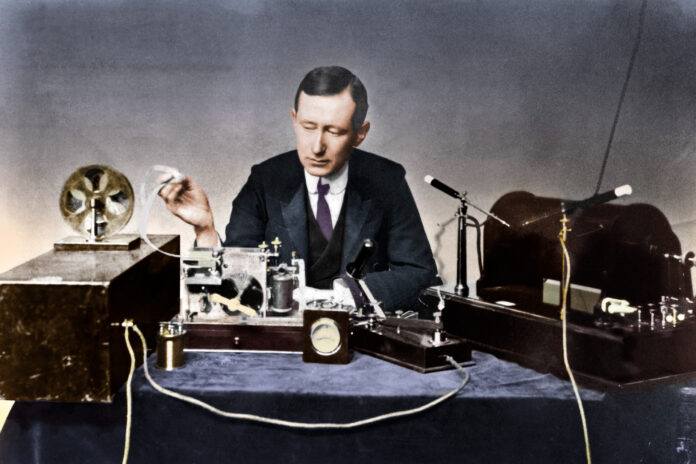Guglielmo Marconi, often celebrated as the “father of radio,” revolutionized communication with his pioneering work in wireless telegraphy. His groundbreaking inventions and relentless pursuit of innovation transformed the way the world transmits information, laying the foundation for modern wireless communication. This article explores Marconi’s life, his significant contributions, and his enduring legacy.
Early Life and Background
Birth and Family
Guglielmo Marconi was born on April 25, 1874, in Bologna, Italy, to Giuseppe Marconi, an Italian aristocrat, and Annie Jameson, an Irish heiress and granddaughter of the founder of Jameson Irish Whiskey. Growing up in a privileged environment, Marconi was exposed to diverse cultures and languages, which broadened his perspective and fueled his curiosity.
Early Education and Influences
Marconi’s interest in science and electricity was evident from a young age. He was educated privately and later attended the Livorno Technical Institute. He was deeply influenced by the works of physicists such as Heinrich Hertz, who demonstrated the existence of electromagnetic waves, and James Clerk Maxwell, whose theories on electromagnetism laid the theoretical groundwork for Marconi’s future experiments.
Career and Scientific Contributions
Early Experiments and Wireless Telegraphy
In the early 1890s, Marconi began conducting experiments in his family’s attic, attempting to transmit wireless signals. By 1895, he succeeded in sending signals over a distance of 1.5 miles. Marconi’s innovation was to use grounded antennas to extend the range of transmission, a significant improvement over previous attempts. His experiments caught the attention of the Italian Ministry of Posts and Telegraphs, but they showed little interest in funding his work.
Move to England and Commercial Development
In 1896, Marconi moved to England, where he found a more receptive audience for his ideas. He demonstrated his wireless telegraphy system to officials at the British Post Office and received a patent for his invention. With financial backing from the British government and private investors, Marconi established the Wireless Telegraph and Signal Company, later known as Marconi’s Wireless Telegraph Company. This company became a major player in the burgeoning field of wireless communication.
Transatlantic Wireless Communication
One of Marconi’s most significant achievements was the successful transmission of wireless signals across the Atlantic Ocean. In 1901, he sent the first transatlantic message from Poldhu, Cornwall, to St. John’s, Newfoundland. This historic event proved the feasibility of long-distance wireless communication and solidified Marconi’s reputation as a leading innovator in the field. The message consisted of the Morse code for the letter “S,” a simple but profound demonstration of wireless technology’s potential.
Improvements and Innovations
Throughout his career, Marconi continued to refine and improve his wireless communication systems. He developed directional antennas, shortwave transmissions, and frequency modulation, all of which enhanced the efficiency and reliability of wireless communication. His innovations laid the groundwork for modern radio, television, and wireless communication technologies.
Major Achievements and Awards
Nobel Prize in Physics
In 1909, Marconi was awarded the Nobel Prize in Physics, shared with Karl Ferdinand Braun, for their contributions to the development of wireless telegraphy. The Nobel Committee recognized Marconi’s pioneering work in creating a practical system for wireless communication and his role in transforming theoretical concepts into real-world applications.
Other Prestigious Awards and Honors
Marconi received numerous other awards and honors throughout his life, including:
- Albert Medal (1912): Awarded by the Royal Society of Arts for his contributions to wireless telegraphy.
- Franklin Medal (1918): Awarded by the Franklin Institute for his advancements in electrical engineering.
- IEEE Medal of Honor (1920): Recognizing his outstanding achievements in the field of radio communication.
Later Years and Legacy
Continuing Innovations
Marconi’s later years were marked by continued innovation and exploration of new technologies. He investigated the potential of microwave communications and contributed to the development of radar during World War II. His work in these areas demonstrated his ongoing commitment to advancing the field of wireless communication.
Personal Life and Character
Marconi’s personal life was as dynamic as his professional career. He was married twice and had five children. Known for his charm and intelligence, Marconi maintained relationships with prominent figures in science, politics, and business. His ability to navigate these circles helped him secure the support and resources needed for his experiments and projects.
Death and Commemoration
Guglielmo Marconi passed away on July 20, 1937, in Rome, Italy. His death was marked by international mourning, and radio stations around the world observed a moment of silence in his honor. Marconi’s contributions to science and communication were commemorated through various memorials, including the Marconi International Fellowship, established to honor individuals who have made significant advancements in communications technology.
Impact on Communication and Technology
Transformation of Communication
Marconi’s work revolutionized communication by making it possible to send messages wirelessly over long distances. This breakthrough had profound implications for industries such as shipping, where wireless communication improved safety and efficiency. It also paved the way for the development of broadcasting, enabling the transmission of news, entertainment, and information to a global audience.
Foundation for Modern Wireless Technology
Marconi’s innovations laid the foundation for the development of modern wireless technology, including radio, television, and cellular communication. His pioneering work in electromagnetic wave propagation and antenna design continues to influence contemporary communication systems. Technologies such as Wi-Fi, satellite communication, and mobile networks all trace their origins back to Marconi’s early experiments.
Influence on Future Generations
Marconi’s legacy extends beyond his technical achievements. He inspired future generations of scientists and engineers to explore the possibilities of wireless communication and to push the boundaries of what was considered possible. His vision and determination serve as a testament to the power of innovation and the impact of scientific discovery.
Challenges and Controversies
Patent Disputes and Rivalries
Marconi’s career was not without its challenges and controversies. He faced numerous patent disputes, particularly with Nikola Tesla, who had also developed early radio technology. These disputes highlighted the competitive nature of technological innovation during the early 20th century. Despite these challenges, Marconi’s contributions were widely recognized, and he is credited with many of the key advancements in wireless communication.
Ethical and Political Implications
Marconi’s work also raised ethical and political questions, particularly regarding the use of wireless technology in warfare and surveillance. During World War I and World War II, wireless communication played a critical role in military operations, raising concerns about the potential for misuse of technology. Marconi himself was involved in the development of radar technology during World War II, reflecting the complex relationship between scientific innovation and its applications.
Personal Reflections and Legacy
Reflections on Career
In his later years, Marconi often reflected on his career and the impact of his work. He expressed pride in his contributions to wireless communication and the ways in which his inventions had transformed society. Marconi’s reflections provide valuable insights into the mindset of a pioneering inventor and the challenges he faced in bringing his vision to life.
Lasting Legacy
Guglielmo Marconi’s legacy is evident in the numerous technologies and systems that rely on wireless communication. His name is commemorated in various institutions, awards, and memorials, ensuring that his contributions to science and technology are remembered and celebrated. Marconi’s work continues to inspire new generations of scientists, engineers, and innovators to explore the possibilities of wireless communication and to push the boundaries of what is possible.
FAQs
1. What are some of Guglielmo Marconi’s most significant achievements?
Some of Guglielmo Marconi’s most significant achievements include the development of the first practical wireless telegraphy system, the successful transmission of wireless signals across the Atlantic Ocean, and numerous innovations in antenna design and frequency modulation.
2. How did Guglielmo Marconi influence the development of modern communication technology?
Guglielmo Marconi influenced the development of modern communication technology by laying the groundwork for wireless communication systems, including radio, television, and cellular communication. His pioneering work in electromagnetic wave propagation and antenna design continues to impact contemporary communication technologies.
3. What awards and recognitions did Guglielmo Marconi receive?
Guglielmo Marconi received numerous awards and recognitions, including the Nobel Prize in Physics (1909), the Albert Medal (1912), the Franklin Medal (1918), and the IEEE Medal of Honor (1920). He is also commemorated through various institutions and memorials that bear his name.
4. How did Marconi’s early life and challenges shape his career?
Marconi’s early life and challenges, including his rigorous education and the initial lack of support from the Italian government, shaped his career by fostering a deep passion for wireless communication and a determination to succeed. His move to England provided him with the resources and support needed to further his experiments and innovations.
5. What is Guglielmo Marconi’s lasting legacy?
Guglielmo Marconi’s lasting legacy is his extraordinary contribution to the field of wireless communication. His work laid the foundation for modern communication technologies and continues to inspire scientists, engineers, and innovators to explore new possibilities in wireless communication. His name remains synonymous with innovation and the advancement of communication technology.
Conclusion
Guglielmo Marconi’s contributions to wireless communication are unparalleled. His pioneering work in developing the first practical system for wireless telegraphy revolutionized the way the world transmits information and laid the foundation for modern communication technologies. From his early experiments in Italy to his groundbreaking transatlantic transmissions, Marconi’s journey is a testament to his brilliance and determination. His achievements continue to inspire and influence scientists, engineers, and thinkers worldwide. As one of Italy’s greatest scientific legends, Guglielmo Marconi’s legacy will endure for generations to come, ensuring that his name remains synonymous with innovation and the advancement of communication technology.

